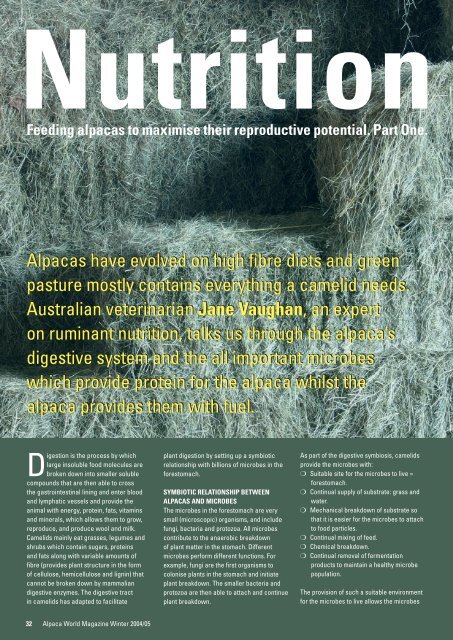You also want an ePaper? Increase the reach of your titles
YUMPU automatically turns print PDFs into web optimized ePapers that Google loves.
Nutrition<br />
Feeding alpacas to maximise their reproductive potential. Part One.<br />
<strong>Alpacas</strong> have evolved on high fi bre diets and green<br />
pasture mostly contains everything a camelid needs.<br />
Australian veterinarian Jane Vaughan, an expert<br />
on ruminant nutrition, talks us through the alpaca’s<br />
digestive system and the all important microbes<br />
which provide protein for the alpaca whilst the<br />
alpaca provides them with fuel.<br />
Digestion is the process by which<br />
large insoluble food molecules are<br />
broken down into smaller soluble<br />
compounds that are then able to cross<br />
the gastrointestinal lining and enter blood<br />
and lymphatic vessels and provide the<br />
animal with energy, protein, fats, vitamins<br />
and minerals, which allows them to grow,<br />
reproduce, and produce wool and milk.<br />
Camelids mainly eat grasses, legumes and<br />
shrubs which contain sugars, proteins<br />
and fats along with variable amounts of<br />
fi bre (provides plant structure in the form<br />
of cellulose, hemicellulose and lignin) that<br />
cannot be broken down by mammalian<br />
digestive enzymes. The digestive tract<br />
in camelids has adapted to facilitate<br />
32 Alpaca World Magazine <strong>Winter</strong> 2004/05<br />
plant digestion by setting up a symbiotic<br />
relationship with billions of microbes in the<br />
forestomach.<br />
SYMBIOTIC RELATIONSHIP BETWEEN<br />
ALPACAS AND MICROBES<br />
The microbes in the forestomach are very<br />
small (microscopic) organisms, and include<br />
fungi, bacteria and protozoa. All microbes<br />
contribute to the anaerobic breakdown<br />
of plant matter in the stomach. Different<br />
microbes perform different functions. For<br />
example, fungi are the fi rst organisms to<br />
colonise plants in the stomach and initiate<br />
plant breakdown. The smaller bacteria and<br />
protozoa are then able to attach and continue<br />
plant breakdown.<br />
As part of the digestive symbiosis, camelids<br />
provide the microbes with:<br />
❍ Suitable site for the microbes to live =<br />
forestomach.<br />
❍ Continual supply of substrate: grass and<br />
water.<br />
❍ Mechanical breakdown of substrate so<br />
that it is easier for the microbes to attach<br />
to food particles.<br />
❍ Continual mixing of feed.<br />
❍ Chemical breakdown.<br />
❍ Continual removal of fermentation<br />
products to maintain a healthy microbe<br />
population.<br />
The provision of such a suitable environment<br />
for the microbes to live allows the microbes







